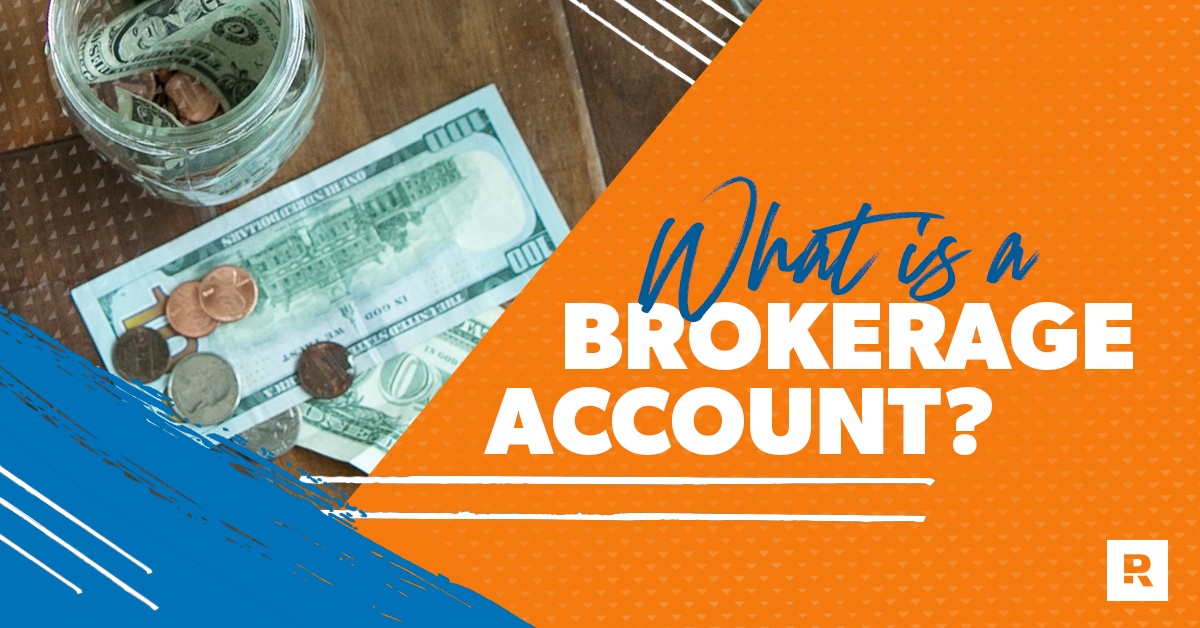While your 401(k) at work and a Roth IRA are the best ways to save for retirement, they’re not the only ways to invest. That’s where a brokerage account comes in.
Under the right circumstances, brokerage accounts (or taxable investment accounts) can give your nest egg a bigger boost beyond your tax-advantaged retirement accounts.
We always recommend investing in your 401(k) and IRA first because they offer tax benefits that you can’t find anywhere else. But when you’ve maxed out those options, a brokerage account might provide you with a place to keep investing. Here’s what you need to know!
What Is a Brokerage Account?
A brokerage account is an investment account you can open directly through a bank or brokerage firm that lets you buy and sell all kinds of different investments. With a brokerage account, you have the freedom to invest in whatever you want—from stocks and mutual funds to bonds and ETFs.
They’re also known as taxable investment accounts because the money that grows in your account will be taxed by Uncle Sam.
How Do Brokerage Accounts Work?
It’s pretty simple: When you want to invest in mutual funds or stocks through a brokerage account, you’ll place an order through the account, deposit the funds, and then the transactions will be carried out for you by the bank or brokerage firm.
There are two main types of brokerage accounts you can choose from: full-service brokerage accounts, which come with some type of financial guidance, or an online brokerage account that you basically manage yourself or with help from a “robo-advisor” (more on those below).
With a brokerage account, you get no tax benefits. Zilch. Instead, you’ll pay taxes on any capital gains, dividends and interest you earn in your account. Let’s break that down a little more!
When you sell investments inside your brokerage account, you’ll pay capital gains taxes on any money you make from the sale . . . but how much you pay is based on how long you owned the investment.
For example, if you bought shares of a mutual fund and held them for a year or longer before selling, you’ll pay the long-term capital gains rate (0%, 10% or 15%, depending on your ordinary income). But if you bought and sold those shares in less than a year, then you’ll be charged at the short-term capital gains rate (which is the same as your income tax rate).1
If you receive dividends from your investment, they will be taxed either at your ordinary income tax rate (for unqualified or “ordinary” dividends) or at your long-term capital gains rate (for qualified dividends) in the same year you received them.
Phew! We know . . . that was a lot to take in. Trying to calculate what you owe in taxes on a brokerage account can get complicated, so you’ll probably want to work with a tax advisor who can help you sort it all out.
Types of Brokerage Accounts
There are several types of brokerage accounts you might come across when looking for one. Here’s what you need to know about each type so that you can pick one that’s right for you.
Full-Service Brokerage Accounts
A full-service managed brokerage account usually comes with help from a financial advisor or a broker. These accounts are usually more expensive since these brokers will charge a fee or commission for making trades or purchases on behalf of their investors.
Online Brokerage Accounts
Online brokerage accounts are made for the do-it-yourself investor. They come with lower fees, but you’re pretty much on your own when it comes to buying and managing your investments.
Market chaos, inflation, your future—work with a pro to navigate this stuff.
Some online brokerage accounts now come with help from “robo-advisors,” which rely on computers and algorithms instead of humans to help build and manage your investment portfolio based on your preferences.
Cash Brokerage Account
With a cash brokerage account, any investments you buy must be paid in full. That means you’re not allowed to borrow any money from a broker to pay for any investment transaction. That’s a good thing, because it prevents you from turning your brokerage firm into a debt collector. Speaking of which . . .
Margin Brokerage Account
Whenever you hear the word margin, think debt. A margin account lets you borrow money from the brokerage firm or bank in order to make trades—you’ll basically be going into debt to invest. That’s a disaster waiting to happen! Because if you borrow money to invest and the value of that investment tanks, the broker you borrowed money from could demand you cover that loss right away.
Listen to us, never borrow money to invest. Not only is it extremely risky, but you’ll also have to pay interest on what you owe.
Ramsey Solutions is a paid, non-client promoter of participating pros.
How to Open a Brokerage Account
Is opening a brokerage account tough to do? Not at all! In just a few easy steps, you can have a brokerage account opened up in no time at all. There are just a few things to keep in mind along the way. Here’s what you need to do:
1. Pick a brokerage firm.
Take some time to compare the costs, fess and services offered by a few brokerage firms before deciding which one is right for you. Ask your investment professional about your options before deciding where to invest your hard-earned cash.
2. Choose the type of brokerage account you want.
According to The National Study of Millionaires, most millionaires work with a financial advisor to help them reach their net worth and they don’t use debt to invest. With that in mind, steer clear of margin accounts at all costs!
3. Fill out an application.
Once you find a brokerage firm you want to open an account with, opening a brokerage account is a pretty simple process that just takes a few minutes to complete. You might need to sign some forms and provide some personal information, like your Social Security number, employment status, net worth and more.
4. Fund the account and start investing.
After you’ve set up your account, you can make an initial deposit or even set up automatic withdrawals from your bank into that investment account each month. Once your account is funded, you can start investing. It’s as easy as that!
What’s the Difference Between Brokerage Accounts and Retirement Accounts?
|
Feature |
Traditional 401(k) |
Roth IRA |
Brokerage Account |
|
Eligibility |
Only available through an employer-sponsored program and there may be a waiting period before enrollment. |
Must have an earned income, but restrictions apply after a certain income based on your filing status. |
Some brokerage firms will require a minimum investment to open an account, but there are no restrictions based on income. |
|
Taxes |
Investments are made with pretax dollars, lowering your taxable income. But you’ll pay taxes on any money you withdraw in retirement. |
Investments are with after-tax dollars, allowing investments to grow tax-free. Plus, no taxes on withdrawals in retirement. Win-win! |
Generally, you will have to pay capital gains taxes when you sell investments through your account. Any dividends and interest you receive will also be taxed in the year you received them. |
|
Contribution Limits |
For 2024, $23,000 per year ($30,500 per year for those 50 or older). |
For 2024, $7,000 per year ($8,000 per year for those age 50 or older). |
There are no restrictions on how much money you can invest into your account. |
|
Investment Menu |
Account is controlled by a third-party administrator who handles (and limits) investment options. |
A wider variety of investment options and more control over how you invest. |
You can buy and sell investments through your broker, who may offer a wider range of investment options, including stocks, mutual funds and bonds. |
|
Withdrawals |
Penalties for withdrawals before age 59 1/2. |
Penalties for withdrawals before age 59 1/2. |
You can take money out of your account at any time without paying fees or penalties. |
When it comes to saving for retirement, there are some major differences between brokerage accounts and tax-advantaged retirement accounts like a 401(k) and Roth IRA. The main difference (and it’s a big one) is how they are taxed.
Brokerage accounts don’t have the same tax benefits as retirement accounts.
With a brokerage account, you don’t get to claim your contributions as tax deductions like you could with your traditional 401(k). And you don’t enjoy tax-free growth or tax-free withdrawals that come with a Roth IRA. That makes brokerage accounts a much less attractive retirement savings option than those tax-advantaged accounts.
Listen, we always recommend maxing out your traditional and Roth retirement accounts before you even consider opening up a brokerage account for retirement savings.
Now, although brokerage accounts don’t have the same tax benefits as tax-advantaged retirement accounts, they do come with fewer restrictions and rules. Here are some of the main benefits of having a brokerage account.
Brokerage accounts have more flexibility.
You can take money out of a brokerage account at any time and for any reason—just like you could with a regular bank account—without paying an early withdrawal penalty. You have to wait until age 59 1/2 to take money out of a 401(k) or IRA without penalty.
Again, max out your retirement accounts first, but brokerage accounts can be used in situations like “bridge accounts” for early retirement or other situations where you need access to the funds.
Brokerage accounts have no contribution limits.
You can put as much money as you want into a brokerage account. You’ve already paid income taxes on the money (from your paycheck), so the government doesn’t care about how much you invest. (And besides, the government will hit you with capital gains taxes later, so they’ll get their taxes anyway.)
The IRS, meanwhile, sets limits on how much you can put into a 401(k) or IRA each year.
Brokerage accounts have no income limits.
It doesn’t matter if you make $25,000 a year or $250,000—anyone can open up a brokerage account and put money in one. You can’t contribute to a Roth IRA if your income rises above a certain level.
In summary: Brokerage accounts are more flexible than retirement accounts, but don’t have some of the same tax advantages.
When Should I Consider Opening a Brokerage Account?
Great question! Keep in mind that working with a financial advisor who can give you guidance on the pros and cons of opening a brokerage account in your situation is always a good idea.
Now, here are four scenarios where a brokerage account might play a big role in helping you reach your financial goals:
1. You maxed out your 401(k) and IRA contributions.
First things first: We recommend you invest 15% of your gross income into tax-advantaged options like your 401(k) and Roth IRA. But if you’ve maxed out your tax-advantaged options and still haven’t invested 15% of your gross income, you can use a brokerage account to help you hit that mark.
For 2024, you can put up to $23,000 in a 401(k) and $7,000 into your IRA. If you’re age 50 or older, you can put in “catch-up contributions” that allow you to invest $30,500 in a 401(k) and $8,000 into an IRA this year.2,3 Make sure you focus on investing as much as you can in those accounts before turning to a brokerage account. You don’t want to miss out on those tax benefits!
Just like with your 401(k) and IRA, we recommend spreading your investments in a brokerage account across four different types of mutual funds: growth and income, growth, aggressive growth, and international.
2. You’re looking to invest beyond 15% of your income.
We want you to dream for a second. Imagine you just made your last mortgage payment and now you’re sitting in a paid-for house. If you had a typical mortgage payment, that means you might have an extra $1,600 every month to work with!3
Having a paid-for house opens up a lot of possibilities for you, like investing beyond 15% of your gross income so that you can really run up the score and squirrel away a huge pile of savings for retirement. A brokerage account might be an option, especially if you want to bump up your retirement by a few years. Speaking of which . . .
3. You want to retire early and avoid early withdrawal penalties.
A lot of Americans dream about retiring early, but the early withdrawal penalty they might get hit with for taking money out of a 401(k) or Roth IRA before age 59 1/2 makes them think twice about it.
To avoid giving Uncle Sam a huge chunk of your nest egg, you might want to set up a brokerage account as a “bridge account” that will give you an income stream to tap into until you’re able to pull from your 401(k) and IRAs. Since you can take money out of a brokerage account at any time and for any reason, they’re perfect for bridging that gap!
4. You have long-term savings goals that you’re saving for.
Brokerage accounts don’t have to be just for retirement! They can also help you reach some important financial goals that might take a long time to reach. For example, if you want to buy a house with cash or save up a very large down payment, a brokerage account might be a good option if you plan to save for about five years.
But for savings goals that will take less than five years, you might want to use a regular savings account or a money market account. You won’t earn very much on those accounts, but you won’t be vulnerable to short-term market swings.
Work With an Investment Pro
Still have questions about brokerage accounts? It’s worth scheduling a meeting with an investment professional.
Our SmartVestor program can help you find an investment professional in your area who can walk you through the pros and cons of your investing options and help you can make informed decisions for your future.
Find an investment pro today!
Read the full article here






